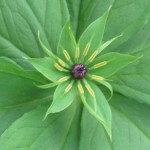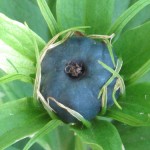Wednesday, June 23, 2010
Above, from left to right: Herb paris (Paris quadrifolia) flourishing in the dappled shade of a quince tree in April (although typically four-leaved, five- and six-leaved forms of herb paris like these are not uncommon); a detail of the narrow-petaled, star-like green flower with golden stamens; detail of the single black fruit, ripening in late June. Photographs by Corey Eilhardt.
Herbe Paris riseth up with one small tender stalke two hands high; at the very top come forth foure leaves directly set one against another in the manner of a Burgundian Crosse or True-love knot: for which cause among the Antients it has been called Herbe True-love.
???John Gerard, the Grete Herbal, or Generall Historie of Plants
Trew-loue among men is that most is of lette,
In hates, in hodes, in porses, is sette.
Trewe-loue in herbers spryngeth in May.
Bot trew-loue of herte went is away.
???Popular Middle English rhyme.
The leaves of herb paris suggested both the the cross of Christ and the true-love knot to the medieval mind, and both these resemblances were exploited allegorically. The popular Middle English rhyme quoted above alludes to the custom of placing the spring-blooming herb paris in hats, hoods, or purses as a charm for luck in love, while stressing how quickly such love is lost. Read more »
Tags: arsenic, Fasciculus Morum, Geoffrey Grigson, Grieve, herb paris, Hortus Sanitatis, John Gerard, Juliet, medicine, mercury, pars, Pietro Mattioli, poison, quadrifolia, quatrefoil of love, Romeo, Susanna Greer Fein, true love, Venus
Posted in Magical Plants, Medicinal Plants | Comments (0)
Friday, June 11, 2010
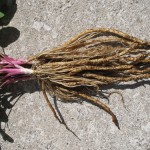
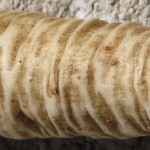
Above, left: a view of the complete skirret plant; right: a closer look at the texture of the skirret root. Photographs by Corey Eilhardt.
Skirret (gerla) is hot and dry. Eaten in moderation, it is not very helpful or harmful. If someone should eat a lot of it, its heat and dryness would stir up fevers in him and harm his intestines. A person whose face has weak skin, which easily splits, should pound skirret in a mortar and add oil. When he goes to bed at night, he should rub it on his face, continuing until he is healed.
???Hildegard von Bingen’s Physica
Read more »
Tags: crummock, gerla, Hildegard von Bingen, Pliny, potato, Sium sisarum, skirret, Tiberius, Umbelliferae
Posted in Food and Beverage Plants, Medicinal Plants | Comments (3)
Friday, June 4, 2010
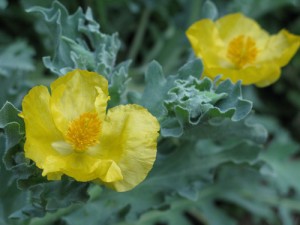
Horned poppy (Glaucium flavum) flowering in Bonnefont Garden in a sunny bed devoted to medicinal plants. Like other members of the poppy family, the horned poppy contains poisonous alkaloids.
The yellow horned poppy hath whitish leaves very much cut or jagged, somewhat like the leaves of garden Poppie, but rougher and more hairie. The stalks be long, round, and brittle. The floures be large and yellow, consisting of foure leaves; which being past, there come long huskes or cods, crooked like an horn or cornet, wherein is conteined small black seede. The roote is great, thicke, scalie, and rough, continuing long.
???John Gerard (1545???1612)
The Elizabethan herbalist John Gerard???s meticulous description of the plant which he names in Latin as Papaver cornutum flore luteo, “the horned poppy with the yellow flower,” was based on personal observation. He notes that it “groweth upon the sands and banks of the sea,” and lists the many places along the English coast where he found it growing. Read more »
Tags: alkaloid, Dioscorides, Eryngium maritimum, Geoffrey Grigson, Glaucium flavum, Hortus Sanitatis, John Gerard, poppy, sea holly, sea poppy
Posted in Medicinal Plants | Comments (1)

